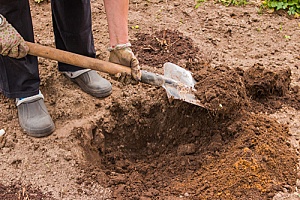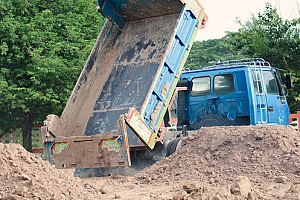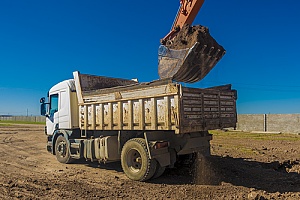 Home construction projects can be a fulfilling challenge. Whether the project takes a few days or a few weeks, many homeowners enjoy the ability to save some money and accomplish a creative task to beautify their homes. Careful planning is important to ensure an enjoyable and safe construction project, which is why fill dirt is so important.
Home construction projects can be a fulfilling challenge. Whether the project takes a few days or a few weeks, many homeowners enjoy the ability to save some money and accomplish a creative task to beautify their homes. Careful planning is important to ensure an enjoyable and safe construction project, which is why fill dirt is so important.
While it is often overlooked, fill dirt is an essential component of many home improvement projects. Without it, you may find yourself on uneven ground or without a strong foundation, causing problems that will need additional money to fix later. Not all fill dirt is created equal, however, so consider your project’s needs and the types of fill dirt available to you. Screened fill dirt is a type of fill dirt that provides the most support for outside construction projects. In this article, you will learn more about this unique type of fill dirt and how it can be of use to you.
What is Fill Dirt?
Fill dirt is dirt that is naturally found beneath the top layer of soil. It does not contain any organic matter and is instead made entirely of broken down rocks, clay, and sand. The lack of organic matter provides better stability for home construction projects. Topsoil and other types of dirt that contain organic matter might settle over time as the matter decomposes. This causes shifting, resulting in uneven foundations or areas in which water can pool and further destabilize the ground. Fill dirt, in contrast, does not shift as much when it is compacted.
Fill dirt is typically used to fill in holes, level the land and grade it to the same elevation, or create new levels in an area. It is an essential part of most home construction projects, including filling in a pool, installing a gazebo or pergola, and building a new living area. Because it contains no organic matter, fill dirt of any kind should not be used in gardens or other areas in which you want plants to grow. Instead, the area should be covered with nutrient-rich topsoil before planting. To ensure that your project is the best it can be, consider using screened fill dirt, a higher-quality variety of fill dirt that adds extra security to your foundation.
The Screened Fill Dirt Difference
 Fill dirt is available in several varieties, including screened. This type of fill dirt does not contain rocks, gravel, or other debris larger than a certain size, typically three-quarters of an inch in diameter. Other grades of screened fill dirt may be available if you need an even finer variety. Unscreened fill dirt, meanwhile, can contain large rocks that are difficult to maneuver around when it comes to transporting the dirt and filling in areas of your project. The screening process breaks up heavy clods of clay, giving the dirt a more uniform consistency, and removes all large particles above a particular size. The dirt is typically moved through mesh screens, sifted, and evaluated to ensure the proper consistency, with some larger items removed by hand if necessary. This extra effort means that screened fill dirt costs more than the unscreened variety. However, the higher price may be worth it for your next project.
Fill dirt is available in several varieties, including screened. This type of fill dirt does not contain rocks, gravel, or other debris larger than a certain size, typically three-quarters of an inch in diameter. Other grades of screened fill dirt may be available if you need an even finer variety. Unscreened fill dirt, meanwhile, can contain large rocks that are difficult to maneuver around when it comes to transporting the dirt and filling in areas of your project. The screening process breaks up heavy clods of clay, giving the dirt a more uniform consistency, and removes all large particles above a particular size. The dirt is typically moved through mesh screens, sifted, and evaluated to ensure the proper consistency, with some larger items removed by hand if necessary. This extra effort means that screened fill dirt costs more than the unscreened variety. However, the higher price may be worth it for your next project.
Which Kind Should You Use?
Unscreened topsoil is suitable for some home improvement projects, such as filling in a pool that will later be covered by a garden or grass. Screened fill dirt, on the other hand, is better suited to tasks that require the creation of a stronger foundation. This is because its lack of large particles lessens the amount of space through which dirt and water can fall or settle. With a stronger foundation, you can feel more confident in building over the land to create living areas, such as an in-law apartment, or areas in which your family will be relaxing, such as a gazebo.
Screened fill dirt is also beneficial when precise measurements are required or when time is of the essence. Because there are no large rocks that might get in the way, you will know exactly how much dirt you need to purchase in order to fill in the necessary area. Screened fill dirt is also better suited to areas in which an accurate grade is required, such as locations in which you need to slope water away from a foundation. You’ll also be able to move the dirt more easily and finish your project more quickly by saving time on picking out materials that would otherwise be unsuitable or dangerous to leave in the dirt.
Finally, screened fill dirt is often checked for chemicals and contaminants when it is prepared as well as checking for large particles. If your area is prone to flooding or heavy rains, screened fill dirt can be a good idea to ensure that no contaminants will reach fresh water sources as water rolls off your land and that your plants and lawn area remain safe.
Obtaining Your Project Materials
 Dirt Connections provides free fill dirt deliveries to commercial and residential construction sites throughout the state, helping to simplify logistics while saving you time and money. If you’re unsure of how much fill dirt to purchase for your project, an experienced contractor can assist you in determining the right type and amount. Dirt Connections can provide fill dirt for any size of project, big or small, and inspects each site for safety prior to delivery. When your project is complete, our fill dirt contractors can remove any excess dirt to leave your site clean and ready for the next phase. For more information about screened fill dirt, or to schedule a Maryland fill dirt delivery, contact Dirt Connections today.
Dirt Connections provides free fill dirt deliveries to commercial and residential construction sites throughout the state, helping to simplify logistics while saving you time and money. If you’re unsure of how much fill dirt to purchase for your project, an experienced contractor can assist you in determining the right type and amount. Dirt Connections can provide fill dirt for any size of project, big or small, and inspects each site for safety prior to delivery. When your project is complete, our fill dirt contractors can remove any excess dirt to leave your site clean and ready for the next phase. For more information about screened fill dirt, or to schedule a Maryland fill dirt delivery, contact Dirt Connections today.








































